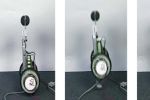Building the Real Iron Man
Afghanistan. A hidden bunker. Four men with rifles guard a thick, rusted steel door. Bam! A huge fist pounds against it—from inside. Bam! More blows dent the steel. The hinges strain. The guards cower, inching backward. Whatever's trying to break out is big. And angry.
The door flies open, and a metallic giant bursts through. It looks like a robot but, hidden inside, famed weapons designer Tony Stark maneuvers the mechanical beast. Bullets bounce off the suit, barely denting his armor. He levels the guards with one swat. Outside, he stares down the enemy camp around him, switches on the flamethrowers in his arms, and roasts the joint.
Utah. A secret mountain lab. Software engineer Rex Jameson backs into a headless metal suit that's hanging from a steel I-beam by a thick rubber cord. He clicks into the aluminum boots, tightens belts across his legs and waist, and slides his arms through backpack-like straps, gripping handles where hands would be. It looks as easy as slipping into an overcoat.
Then he moves, and the machine comes to life, shadowing his every motion. He raises his fists and starts firing sharp jabs while bouncing from one foot to the other. He's not quite Muhammad Ali, but he's wearing 150 pounds and he looks light.
He could easily knock a nearby coder to the floor, or fling one over a desk—but even more impressive, he could do it all day. To show off his superhuman endurance, he walks over to a weight rack and yanks down a bar loaded with 200 pounds. Then he does it again. And again. He stops somewhere around 50, but he's been known to rip through 500 reps in a row. Even then, he quits out of boredom, not fatigue.It's fantasy versus reality, and the spread is shrinking. The latter, the XOS, is the latest and arguably most advanced exoskeleton in existence, developed by one-man idea factory Steve Jacobsen and the engineers at Sarcos, a robotics company he started in 1983 that was recently purchased by the defense giant Raytheon. The flame-throwing monster? That's the star of the superhero blockbuster Iron Man, due out May 2. The film follows a prolific inventor named Tony Stark who builds a robotic suit of armor that grants him fantastical abilities. Iron Man has been thriving in comics for more than four decades, but this is Hollywood's first go at the story. And the timing couldn't be better. Not only is Iron Man—a hero born of pure engineering—the perfect idol for our gadget-obsessed era, but for the first time since the character appeared, the suit is more than just an illustrated dream.
In the past seven years, a handful of engineers have taken the military's 40-year-old fantasy of mechanically enhanced soldiers that can carry heavy loads and begun to make it real. Funded with millions from the Pentagon's Defense Advanced Research Projects Agency (Darpa), Jacobsen and others have finally begun marrying artificial muscles and control systems into suits that could soon be available to soldiers, firemen and the wheelchair-bound. There are still serious challenges—powering these wearable robots, for one—but Sarcos's XOS, the most capable full-body suit, one that moves seamlessly with its wearer, has even the comic's creators feeling like the real world is catching up to their vision. After Adi Granov, one of the main illustrators of the comic and a consultant to the film, watched a clip of the suit in action, he was startled. "I knew that's where we were heading, but I didn't realize we were this close," Granov says. Aside from the lack of flight and weapons, he adds, "that's Iron Man."
Check out video of the XOS in action here, and for a brief photo history of the man-made exoskeleton, see our gallery here. Continue reading this feature below.
34 Comments
Popular Tags
SciTech
Regular Features

Featured
SciTech
Science Confirms the Obvious 2008
The findings may be no-brainers (yes, you do get sick in winter), but these studies uncover hidden truths in conventional wisdomBuilding the Real Iron Man
While audiences flood theaters this month to see the comic-book-inspired Iron Man, a real-life mad genius toils in a secret mountain lab to make the mechanical superhuman more than just a fantasy with the XOS Exoskeleton
Popular on Popsci
Most Viewed
Most Commented
SciTech
- High Speed Rail Link to Make Canberra Sydney’s Second Airport
- Tilt Train Technology
- Are You Going to Eat That?
- Bigger Balls - PopSci Investigates Tennis
- Cheap Supplements Relieve Migraines
- An Apple By Any Other Name
- Stay Healthy or Go Blind!
- We Are What Our Parents Ate
- The Secret of Successful Kissing
- Eye Muscles Avoid Paralyses
Most Emailed
SciTech
- The Secret of Successful Kissing
- Valentine's Day Tips for Cavemen and Beetles
- The Science of Snobbery
- Puzzling Together Human Origins
- Eye Muscles Avoid Paralyses
- Tilt Train Technology
- Limbs, Prosthetics, and Tusks, Oh My!
- High Speed Rail Link to Make Canberra Sydney’s Second Airport
- Birth Order Can Affect Relationship Compatibility
- Delay (Anew) for the LHC Restart









Comments
sexy.
46 out of 79 people found this comment helpfulI'd rather have a HAL-5. Do an image search for it, it's pretty awesome. And it's been around for years.
16 out of 32 people found this comment helpful=O wow
10 out of 49 people found this comment helpfulJust out of curiosity, if you were lifting weights in the suit, would that build your muscle? If so, it could help people in rehabilitations to lift like a bajillion pounds and gain there muscle back, or help me show off to the ladies :)
Ewok:
It wouldnt matter if you could lift a million pounds in the suit, you gain muscle on how much YOU lift. So if the suit makes lifting a million pounds equivalent to lifting 10 pounds... you might as well just lift a 10 pound weight because its the same.
^_^
31 out of 43 people found this comment helpfulHmm thats pretty cool. I can see why the military is paying out-the wazoo for this thing. Personaly i think it should be used for construction, to save on energy and only have to endanger 3 men instead of 50.
Also i dont like the idea of wasting it fighting battles, it seems like kind of a waste if u ask me.
And the disabled thing is a really great idea if you can make it less noticeable, and or bulky.
-Word.of.Warcraft
19 out of 31 people found this comment helpfulI like the idea of an exo suit, but using hydrualics to move the limbs seems outdated for something so advanced. when will they come up with some type of synthetic muscle that minipulates the human muscle better adn faster.
11 out of 25 people found this comment helpfulI think idea is good and maybe not a perfect but still it is a
10 out of 19 people found this comment helpfulbeginning /in progress I mean/.
Maybe when that apparatus have more good connection with
human body and they work in symbiosis...
from Houston, Tx
The technology is facinating, though I fear that we are moving far to slowly with advancements in science. It is taking far to long to come up with new advancements. There are not enough people that are of literal genius status or near genius status involving themselves in science. Myself, I am ashamed that I don't even know how to type or spell properly, even though I was seen as a pheonom as a child. Remember Einstein was bad with phone numbers. I need to educate myself. I fear it is coming far to late in my life, but I have to try. I spent to much time drinking beer, and not enough time diving into books. I will say this for the exo-skeleton, it is worth waiting for. The applications are going to be quite varried. I just don't want to see a college kid hitting a bong off campus meeting his death to the new rookie of the patrol squad as he rolls up and torches the poor chitlin... Ow!
CAN YOU SAY POLICE BRUTALITY?
14 out of 24 people found this comment helpfulHey mwesty64, I dont see how hydraulics are outdated. That would be like saying I dont see why they use wheels for cars, they should hover by now. An application such as this uses quite advanced technology to sync appropriately with the movement of the body and could be used for a number of different things other than supplementing a human engaged in combat....
16 out of 21 people found this comment helpfulfrom St. Louis, Missouri
This is an old idea in the science fiction world going back to the 40s, 50s and 60s. If you are going to do a power suit timeline, how about mentioning Robert Heinlein's flying (or at least high-jumping) combat power suits in his original Starship Troopers novel (1959) or the power suit in the Robocop (1989) movies.
Anytime a human and a machine integrate in an intimate way to perform tasks that a human being could not perform on his or her own, (Steve Auston, The Six Million Dollar Man-1973 anyone?) you essentially have a cyborg, even if the connection is only temporary. It doesn't matter if the machine is enhancing human muscles/sensors or replacing them.
Of course the suits will eventually be used in other than military roles. It’s call “spin-off” and it has been going on since military technology started to advance from stone knives and bear skin shields. Most likely the first civilian application for the military type of power suit will be heavy construction.
However, this is not an either or situation. This technology can be applied to both civilian and military uses without taking away from either one. But I guess it’s pretty easy to talk about the use of such power suits to defend the United States and give our troops the best protection and firepower as a “waste” when your sitting safe, sound and free here in the states while someone else is doing the heavy lifting to defend you overseas, isn’t it?
It should be mentioned that power "waldo" (again, from Robert Heinlein in his 1942 short story of the same name) style mechanical "hands" are already being used for dangerous remote work and medical applications. Such manipulators can scale up or down (for delicate work like micro-surgery) the movements and apparent strength of the operator’s hands and arms. They have been used for years in the medical, chemical and nuclear industries.
One suggestion... No armor is truly impervious against the right kind of counter weapons. Even heavily armored tanks can be destroyed or penetrated with certain types of shoulder launched rockets and even high caliber rifle fire. So, there will be casualties, even amongst soldiers wearing heavily armored power suits. It might be a good idea to program the electronics in the power suit to automatically run, walk or even crawl (if the machine can still move at all) the wounded or dead combat soldier back to his own lines, once the on-board computer determines by monitoring the physical condition of the operator that the soldier in incapacitated.
This way, a wounded trooper could get medical attention as soon as possible or, at least, the body could be recovered. It would also keep the formidable weapon that the suit represents from falling into enemy hands. Biometric lock-out systems could also be used to prevent an enemy from acquiring a usable power suit.
This might be a good idea for the current crop of military tanks and armored vehicles in cases where the machine can still function, but the occupants are out of action. The robot vehicle driving systems that have won the DARPA trials could point the way to such automated recovery systems.
14 out of 24 people found this comment helpful